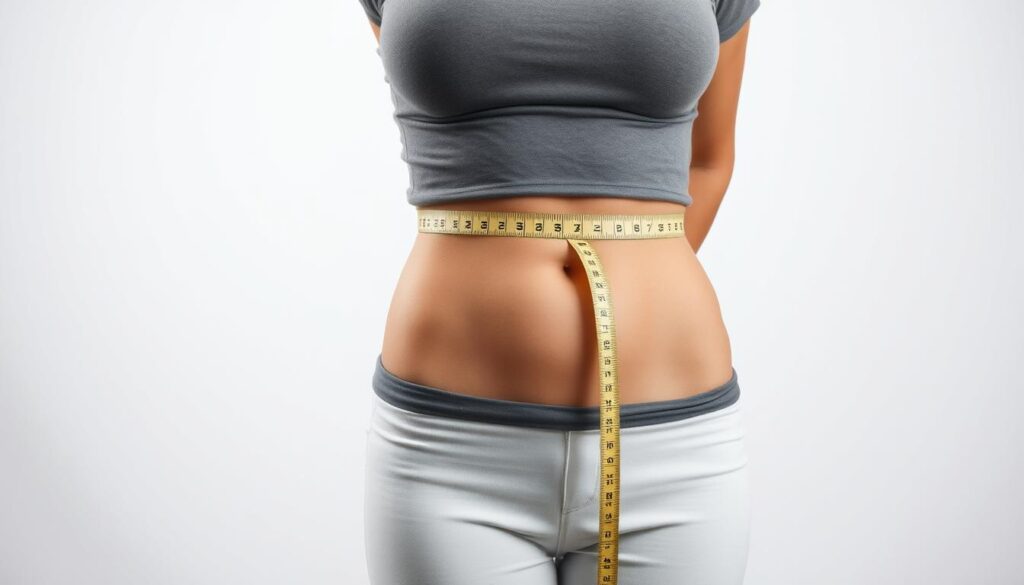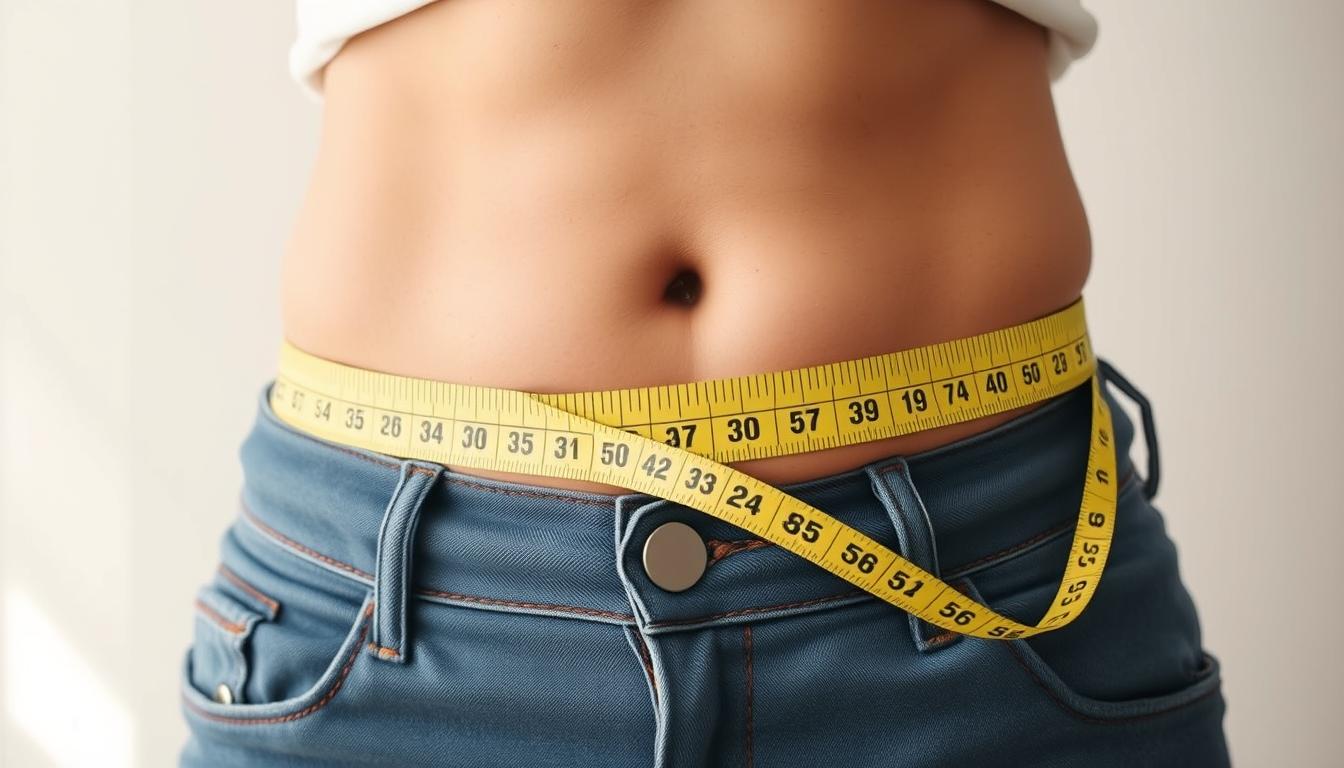Body fat isn’t just about appearance. While many focus on trimming waistlines or shedding pounds, a hidden layer of deep abdominal fat—visceral fat—could be silently impacting your health. Unlike the fat you can pinch, this internal type wraps around organs like the liver and pancreas, increasing risks for heart disease and diabetes.
Tracking your body composition matters more than you think. Tools like a simple tape measure or BMI calculations offer clues about your visceral fat levels. For example, the Cleveland Clinic notes that even people at healthy weights might carry dangerous amounts of this internal fat.
We’ll walk you through practical, science-backed ways to estimate visceral fat without expensive scans. These steps help you take control of your wellness journey. After all, managing your body’s hidden risks starts with understanding them.
Key Takeaways
- Visceral fat surrounds vital organs and poses serious health risks, even if you look healthy.
- Basic tools like a tape measure can provide rough estimates of internal fat levels.
- Waist size and BMI are indirect but accessible indicators for home tracking.
- Diet and exercise directly influence visceral fat reduction over time.
- Accurate measurements help tailor weight management strategies effectively.
Understanding Visceral Fat and Its Health Impacts
The human body stores fat in two distinct layers. While most people recognize the soft layer beneath the skin, a deeper type surrounds vital organs like the liver and intestines. This hidden layer—visceral fat—behaves differently than its surface counterpart and poses unique challenges.
Differences Between Visceral and Subcutaneous Fat
Subcutaneous fat sits just under the skin and can be measured by pinching folds at the waist or thighs. In contrast, visceral fat lies beneath abdominal muscles, wrapping around internal organs. Its location makes it metabolically active, releasing hormones that disrupt body functions.

Men often store more visceral fat around their midsection, while women tend to accumulate it lower in the body. These differences in shape and distribution explain why waist measurements matter more than overall weight for assessing health risks.
Health Risks Associated With Excess Visceral Fat
Research shows excess visceral fat increases risk for heart disease by 32% in adults with waist sizes above 40 inches (men) or 35 inches (women). It also elevates diabetes likelihood by interfering with insulin regulation.
A 2023 Johns Hopkins study found individuals with high waist-to-hip ratios had 58% higher stroke risk. Unlike subcutaneous fat, this deep layer produces inflammatory substances that damage blood vessels and health over time.
Managing visceral fat requires understanding its unique risk health problems. By focusing on this hidden layer, we can create targeted strategies that protect both body and organs from long-term damage.
How to measure visceral fat at home: Step-by-Step Methods
Your waistline holds secrets that go beyond clothing sizes. With basic tools like a tape measure, you can uncover insights about your body composition. Let’s explore simple techniques to track abdominal fat trends over time.

Mastering Waist Circumference Tracking
Start by locating your natural waist—the midpoint between your ribcage and hip bones. Wrap the tape measure snugly around this area without compressing the skin. Ensure the tool stays parallel to the floor for accuracy.
Record measurements in inches, ideally first thing in the morning. Consistency matters: use the same tape measure each time and avoid post-meal checks. Studies show variations exceeding 0.5 inches between sessions suggest measurement errors.
Decoding Ratio Calculations
Two formulas enhance your analysis:
- Waist-to-height ratio: Divide waist size by height (both in inches). Values above 0.5 signal elevated risks.
- Waist-to-hip ratio: Measure the widest part of your hips, then divide waist by hip measurements.
| Ratio | Healthy Range | Elevated Risk |
|---|---|---|
| Waist-to-height | Below 0.5 | 0.5+ |
| Waist-to-hip (Women) | Below 0.85 | 0.85+ |
| Waist-to-hip (Men) | Below 0.9 | 0.9+ |
For example, a 32-inch waist paired with 66-inch height equals a 0.48 ratio—within safe limits. These metrics help identify patterns even if your weight appears stable.
Regular tracking creates a clear picture of abdominal fat changes. Combine these methods with lifestyle adjustments for targeted body composition improvements.
Calculating Body Fat and Utilizing Body Mass Index
Numbers tell stories about our health that mirrors can’t reveal. The body mass index (BMI) offers a quick snapshot of your body composition using just weight and height. While not perfect, this tool helps millions identify potential health risks tied to excess fat.
Determining Your BMI Accurately
Calculate your mass index by dividing your weight in pounds by your height in inches squared, then multiplying by 703. For example: a 150-pound person who’s 65 inches tall (5’5”) would compute (150 ÷ 4225) × 703 = 24.9. This falls within the healthy range of 18.5–24.9.
Use these steps for precision:
- Measure weight first thing in the morning
- Stand against a wall with heels touching for height accuracy
- Recalculate monthly to track trends
Understanding the Limitations of BMI
Muscle weighs more than fat, so athletes might show high BMIs despite low body fat. Older adults often face the opposite—declining muscle mass can mask excess visceral fat. A 2023 study found BMI misclassifies body composition in 30% of adults over 60.
Pair BMI with waist measurements or assessing body composition tools for clearer insights. A BMI above 30 often correlates with higher visceral fat levels, increasing diabetes risks by 42% according to Johns Hopkins data.
Think of BMI as a starting point—not a final verdict. Combine it with other methods like skinfold tests or smart scales to map your total body health picture. Small changes in diet and activity can shift both your mass index and hidden fat stores over time.
Advanced Techniques: Calipers and Smart Scales
Advanced tools offer clarity beyond basic measurements. While waist tapes and ratios provide general insights, specialized devices deliver detailed snapshots of your body fat distribution. These methods bridge the gap between estimation and precision.
Using Skinfold Calipers Effectively
Skinfold calipers measure fat thickness at key sites like the triceps, thigh, and abdomen. By pinching subcutaneous layers, they estimate total body fat percentage. Accuracy depends on consistent technique:
- Take three measurements per site
- Use the same caliper model each time
- Record during morning hours
Benefits of Smart Scales in Tracking Body Fat
Modern smart scales use bioelectric impedance to analyze mass composition. These devices send harmless currents through your body, differentiating muscle from fat. Results update in minutes, showing trends in visceral and subcutaneous stores.
Tips for Consistent Measurements
Variations in hydration or meal timing skew readings. For reliable data:
- Measure before eating/drinking
- Stand barefoot on clean surfaces
- Avoid exercise 3 hours prior
While advanced tools require practice, they reveal patterns simple methods miss. Pair caliper tests with smart scale data to refine your weight loss strategy. Over time, these insights help target stubborn visceral fat zones more effectively.
Lab-Based Testing: When Precision is Needed
Medical technology reveals what household tools cannot. While home methods estimate abdominal fat trends, clinical tests deliver exact maps of your body fat distribution. These gold-standard approaches help diagnose hidden risks tied to chronic disease.
Overview of DEXA Scans and Underwater Weighing
DEXA scans use low-dose X-rays to differentiate bone, muscle, and fat across your total body. This 10-minute procedure identifies visceral deposits near organs with 98% accuracy. Johns Hopkins Medicine recommends it for patients preparing for bariatric surgery.
Hydrostatic weighing submerges you in water to measure density. Lean tissue sinks, while fat floats—this principle calculates total body fat percentage within 1.5% error margins. Though precise, most clinics phased it out for faster options like BOD POD air displacement.
When to Consider Professional Testing
Clinical assessments prove valuable when:
- Home measurements suggest elevated risk health markers
- Managing conditions like hypertension or prediabetes
- Tracking medical interventions impacting blood pressure or organ function
| Method | Accuracy | Time | Cost |
|---|---|---|---|
| DEXA Scan | 98% | 10-15 minutes | $100-$300 |
| Hydrostatic | 95% | 30 minutes | $150-$250 |
| BOD POD | 97% | 10 minutes | $50-$100 |
Mayo Clinic notes these tests often reveal links between visceral fat and blood pressure spikes. However, limited insurance coverage and appointment availability make them impractical for routine use. Reserve lab testing when lifestyle changes plateau or health complications emerge.
“DEXA provides unparalleled insight into fat distribution patterns affecting cardiac outcomes.”
Consider professional analysis if waist measurements exceed 35 inches (women) or 40 inches (men) alongside high BMI. While costly, these snapshots empower targeted treatment plans for at-risk individuals.
Integrating Lifestyle and Exercise for Fat Reduction
Small daily choices can lead to significant reductions in dangerous fat. Combining smart nutrition with targeted movement creates sustainable changes that shrink harmful deposits around organs. Let’s explore strategies backed by science to reshape your body composition and lower health problems.
Nutrition and Exercise for Reducing Visceral Fat
Focus on whole foods like leafy greens, lean proteins, and fiber-rich legumes. These choices stabilize blood sugar and reduce belly fat storage. Pair this approach with exercises that boost heart rate and muscle mass:
- Brisk walking: 30 minutes daily lowers visceral fat by 7% over six months
- Resistance training: Builds muscle to increase calorie burn during rest
| Exercise Type | Frequency | Impact |
|---|---|---|
| High-Intensity Interval Training | 3x/week | Targets deep abdominal fat |
| Yoga/Pilates | 5x/week | Reduces stress-related fat storage |
| Swimming | 2x/week | Engages core without joint strain |
Tracking Progress and Adjusting Your Plan
Women often see faster results with consistent cardio, while men respond well to combined strength and endurance training. Use these tracking methods:
- Weekly waist measurements
- Energy level journaling
- Clothing fit assessments
Adjust workout intensity if progress stalls. Remember, reducing heart disease risk and improving organ function make this journey worthwhile. Every step toward a leaner midsection strengthens your body’s defense against chronic conditions.
Conclusion
True health metrics often lie beyond what’s visible. Through understanding body fat types and tracking methods, we gain power over hidden risks. Whether using waist ratios or professional scans, consistent monitoring reveals patterns affecting our organs and long-term wellness.
Excess visceral fat and subcutaneous fat both contribute to heart disease and diabetes risks. Simple tools like waist measurements provide early warnings, while lifestyle changes address root causes. Pair these strategies with medical guidance when numbers signal deeper health problems.
Every body responds uniquely to diet and exercise. Track trends monthly, celebrate small wins, and adjust plans as needed. Reducing internal fat isn’t just about appearance—it’s about strengthening defenses against chronic conditions.
Start today: measure your waist, review your habits, and take one actionable step. Together, we can reshape our health narratives through informed, intentional choices.


